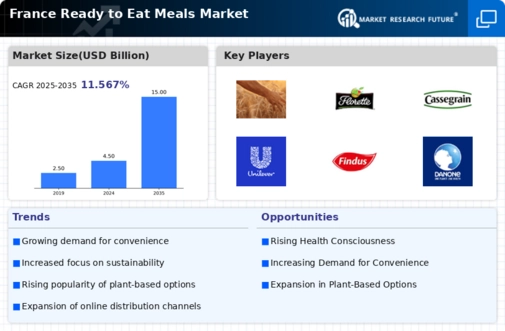Health and Wellness Trends
The growing awareness of health and wellness among French consumers is reshaping the ready to-eat-meals market. There is a noticeable shift towards meals that are not only convenient but also nutritious. Consumers are increasingly scrutinizing ingredient lists, seeking options that are low in preservatives, high in protein, and rich in vitamins. In 2025, it is estimated that around 40% of the ready to-eat-meals market will be driven by health-conscious consumers. This trend is prompting manufacturers to reformulate existing products and introduce new lines that align with health trends, such as plant-based meals and organic ingredients. As a result, the ready to-eat-meals market is evolving to meet the demands of a more health-oriented consumer base, potentially leading to increased sales and market share for brands that prioritize wellness.
Diverse Culinary Preferences
France is renowned for its rich culinary heritage, and this cultural backdrop significantly influences the ready to-eat-meals market. Consumers are increasingly looking for meals that reflect their diverse tastes and preferences, including regional specialties and international cuisines. This demand for variety encourages manufacturers to innovate and expand their product lines, offering meals that cater to different palates. In 2025, it is projected that approximately 30% of consumers will actively seek out ready to-eat-meals that feature unique flavors and ingredients. This trend not only enhances consumer satisfaction but also drives competition among brands to create distinctive offerings. As a result, the ready to-eat-meals market is likely to see an influx of products that celebrate culinary diversity, appealing to both traditionalists and adventurous eaters alike.
Convenience and Time-Saving Solutions
The increasing pace of modern life in France has led to a growing demand for convenience in meal preparation. Consumers are increasingly seeking ready to-eat-meals that require minimal preparation time, allowing them to balance work and personal commitments more effectively. This trend is particularly evident among busy professionals and families, who often prioritize quick meal solutions. The ready to-eat-meals market is responding to this demand by offering a variety of options that can be consumed on-the-go or require only heating. In 2025, it is estimated that the convenience factor will drive a substantial portion of the market, with a projected growth rate of around 15% annually. As a result, manufacturers are innovating to create meals that not only save time but also cater to diverse dietary preferences, thereby enhancing their appeal in the ready to-eat-meals market.
Rising Demand for Sustainable Packaging
Sustainability is becoming a pivotal concern for consumers in France, influencing their purchasing decisions in the ready to-eat-meals market. As environmental awareness grows, there is an increasing demand for products that utilize eco-friendly packaging solutions. Consumers are more likely to choose brands that demonstrate a commitment to reducing their environmental footprint. In 2025, it is projected that around 25% of consumers will prioritize ready to-eat-meals packaged in sustainable materials. This shift is prompting manufacturers to explore biodegradable and recyclable packaging options, which not only appeal to eco-conscious consumers but also align with regulatory trends aimed at reducing plastic waste. Consequently, the ready to-eat-meals market is likely to see a transformation in packaging practices, reflecting a broader commitment to sustainability.
Technological Advancements in Food Production
Technological innovations are playing a crucial role in the evolution of the ready to-eat-meals market. Advances in food processing, packaging, and preservation techniques are enabling manufacturers to enhance product quality and shelf life. For instance, the use of vacuum sealing and modified atmosphere packaging helps maintain freshness and flavor, which is essential for ready to-eat-meals. In 2025, it is anticipated that these technological advancements will contribute to a market growth rate of approximately 12%. Furthermore, the integration of smart technology in food preparation, such as microwaveable meals that can be controlled via mobile apps, is likely to attract tech-savvy consumers. This trend indicates that the ready to-eat-meals market is not only adapting to consumer preferences but also leveraging technology to improve overall product offerings.























Leave a Comment